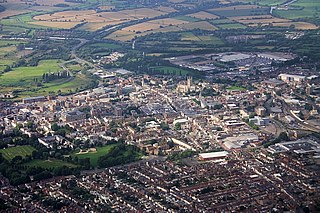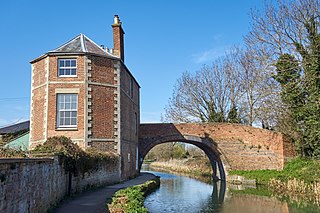Bibliography
- Bick, David (2003). The Hereford and Gloucester Canal. Oakwood Press. ISBN 0-85361-599-3.
- Potter, Hugh (September 2011). "Entrepreneurs with shovels". Waterways World. ISSN 0309-1422.
- Squires, Roger (2008). Britain's restored canals. Landmark Publishing. ISBN 978-1-84306-331-5.
Related Research Articles

The River Severn, at 220 miles (354 km) long, is the longest river in Great Britain. It is also the river with the most voluminous flow of water by far in all of England and Wales, discharging an average of 107 m3/s (3,800 cu ft/s) into the Bristol Channel at Apperley, Gloucestershire. It rises in the Cambrian Mountains in mid Wales, at an altitude of 2,001 feet (610 m), on the Plynlimon massif, which lies close to the Ceredigion/Powys border near Llanidloes. The river then flows through Shropshire, Worcestershire and Gloucestershire. The county towns of Shrewsbury, Gloucester and the City of Worcester lie on its course.

Gloucester is a cathedral city and the county town of Gloucestershire in the South West of England. Gloucester lies on the River Severn, between the Cotswolds to the east and the Forest of Dean to the west, 19 miles (31 km) east of Monmouth, and 17 miles (27 km) east of the border with Wales. Including suburban areas, Gloucester has a population of around 150,000. It is a port, linked via the Gloucester and Sharpness Canal to the Severn Estuary.

Waterway restoration is the activity of restoring a canal or river, including special features such as warehouse buildings, locks, boat lifts, and boats. In the United Kingdom, Canada and the United States, the focus of waterway restoration is on improving navigability, while in Australia the term may also include improvements to water quality. (For water quality improvement activity in the US and UK see stream restoration.)

The Thames and Severn Canal is a canal in Gloucestershire in the south of England, which was completed in 1789. It was conceived as part of a canal route from Bristol to London. At its eastern end, it connects to the River Thames at Inglesham Lock near Lechlade, while at its western end, it connects to the Stroudwater Navigation at Wallbridge near Stroud, and thence to the River Severn. It has one short arm (branch), from Siddington to the town of Cirencester. It includes Sapperton Tunnel, which when built was the longest canal tunnel in Britain, and remains the second-longest complete tunnel. There were always problems with water supply, as no reservoirs were built, while the summit section near the tunnel ran through porous limestone, and there were constant difficulties with leakage. Competition from the railways took much of the canal's traffic by the end of the 19th century, and most of the canal was abandoned in 1927, the remainder in 1941.

The Herefordshire and Gloucestershire Canal is a canal in the west of England, which ran from Hereford to Gloucester, where it linked to the River Severn. It was opened in two phases in 1798 and 1845, and closed in 1881, when the southern section was used for the course of the Ledbury and Gloucester Railway. It is the subject of an active restoration scheme.

Ledbury is a market town and civil parish in the county of Herefordshire, England, lying east of Hereford, and west of the Malvern Hills.

Newent is a market town and civil parish about 10½ miles north-west of Gloucester, England. Its population was 5,073 at the 2001 census, rising to 5,207 in 2011, and estimated in 2019 at 5,082. Once a medieval market and fair town, its site had been settled at least since Roman times. The first written record of it appears in the 1086 Domesday Book.

The Wey and Arun Canal is a partially open, 23-mile-long (37 km) canal in the southeast of England. It runs southwards from the River Wey at Gunsmouth, Shalford, Surrey to the River Arun at Pallingham, in West Sussex. The canal comprises parts of two separate undertakings – the northern part of the Arun Navigation, opened in 1787 between Pallingham and Newbridge Wharf, and the Wey and Arun Junction Canal, opened in 1816, which connected the Arun at Newbridge to the Godalming Navigation near Shalford, south of Guildford. The Arun Navigation was built with 3 locks And 1 Turf sided Flood Lock.The Junction canal was built with 23 locks

The Montgomery Canal, known colloquially as "The Monty", is a partially restored canal in eastern Powys and northwest Shropshire. The canal runs 33 miles (53 km) from the Llangollen Canal at Frankton Junction to Newtown via Llanymynech and Welshpool and crosses the England–Wales border.

The Stroudwater Navigation is a canal in England which linked Stroud to the River Severn. It was authorised in 1776, although part had already been built, as the proprietors believed that an Act of Parliament obtained in 1730 gave them the necessary powers. Opened in 1779, it was a commercial success, its main cargo being coal. It was 8 miles (13 km) in length and had a rise of 102 ft 5 in (31.22 m) through 12 locks. Following the opening of the Thames and Severn Canal in 1789, it formed part of a through route from Bristol to London, although much of its trade vanished when the Kennet and Avon Canal provided a more direct route in 1810. Despite competition from the railways, the canal continued to pay dividends to shareholders until 1922, and was not finally abandoned until 1954.

Llanthony Secunda Priory was a house of Augustinian canons in the parish of Hempsted, Gloucestershire, England, situated about 1/2 a mile south-west of Gloucester Castle in the City of Gloucester. It was founded in 1136 by Miles de Gloucester, 1st Earl of Hereford, a great magnate based in the west of England and the Welsh Marches, hereditary Constable of England and Sheriff of Gloucestershire, as a secondary house and refuge for the canons of Llanthony Priory in the Vale of Ewyas, within his Lordship of Brecknock in what is now Monmouthshire, Wales. The surviving remains of the Priory were designated as Grade I listed in 1952 and the wider site is a scheduled ancient monument. In 2013 the Llanthony Secunda Priory Trust received funds for restoration work which was completed in August 2018 when it re-opened to the public.

Whitchurch Waterway Trust is a registered charity that exists to promote the management and restoration of the Whitchurch Arm of the Llangollen Canal. It was formed in 1988, in response to plans by Whitchurch Town Council to bring the canal back into the town, as a way of promoting tourism.
The Droitwich Canals Trust is an English limited company created in 1973 to work towards the restoration of the Droitwich Canal. From 2001 it worked as part of a larger group, the Droitwich Canals Restoration Partnership, and in 2004, following a successful application for a grant of £4.6 million from the Heritage Lottery Fund surrendered its lease on the canal to British Waterways, who then managed the restoration through to the reopening of the canals in 2011.

The Ledbury and Gloucester Railway, was a railway line in Herefordshire and Gloucestershire, England, running between Ledbury and Gloucester. It opened in 1885 and closed in 1964.

Newent railway station served the town of Newent.

The River Leadon is a river in Herefordshire and Gloucestershire, England, a tributary of the River Severn. It rises just south of the village of Acton Beauchamp, and flows south past Bosbury to the town of Ledbury, which takes its name from the river. It then flows south and east past Dymock, Upleadon and Highleadon to join the Severn at Over, just west of Gloucester. The river is approximately 32 miles (51 km) long.

Hereford Road Skew Bridge is a disused railway bridge in Ledbury, Herefordshire. Built in 1881 to carry the Ledbury and Gloucester Railway across the Hereford Road at an angle of approximately 45°, it was built as a ribbed skew arch with stone spandrels and wing walls, and ribs of blue brick. The railway line was closed in 1959 and the bridge is now used as part of the Ledbury Town Trail footpath.

The Cotswold Canals Trust is an English registered charity that aims to protect and restore the Stroudwater Navigation and the Thames and Severn Canal. The group was founded in 1972, and was initially called the Stroudwater Canal Society. The society became the Stroudwater, Thames and Severn Canal Trust in 1975 as the scope of the project increased, and subsequently became the Cotswold Canals Trust in July 1990.

Ledbury Signal Box is a typical Great Western Railway traditional lever frame signal box which remains in daily use at Ledbury Station, Herefordshire, England on the railway line from Worcester to Hereford.
References
- ↑ Bick 2003, pp. 55, 58.
- 1 2 Bick 2003 , p. 65
- ↑ Squires 2008, p. 113.
- ↑ Historic England. "Canal Bridge Yarkhill (1349186)". National Heritage List for England . Retrieved 26 December 2012.
- 1 2 Potter 2011 , p. 82
- ↑ "WebCHeck (enter 02704407 in Company Number box)". Companies House. Retrieved 26 December 2012.
- ↑ Potter 2011 , p. 85